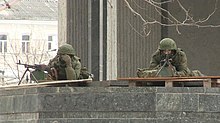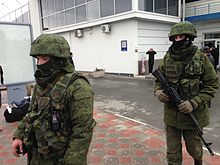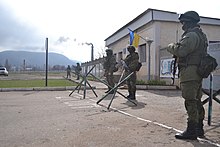
Back رجال خضر صغار (الحرب الروسية الأوكرانية) Arabic Ветлівыя людзі Byelorussian Zelení mužíčci (rusko-ukrajinská válka) Czech Сапăр çынсем CV Grüne Männchen German Hombrecitos verdes (guerra ruso-ucraniana) Spanish Rohelised mehikesed Estonian مردان سبز کوچک (جنگ روسیه و اوکراین) Persian Pienet vihreät miehet (Ukrainan kriisi) Finnish Petits hommes verts (guerre russo-ukrainienne) French



| External Media | |
|---|---|

The "little green men" (Russian: зелёные человечки zelyonye chelovechki; Ukrainian: зелені чоловічки zeleni cholovichky) were Russian soldiers who were masked and wore unmarked uniforms upon the outbreak of the Russo-Ukrainian War in 2014. They were active just before and during the Russian annexation of Crimea and carried regular weapons and equipment, but were always masked and wore distinctly unmarked green military fatigues.[1] Russia, which had been denying any involvement in Ukraine prior to the annexation, used these little green men to give it plausible deniability on the international stage.
Between February and March 2014, these unmarked Russian soldiers occupied and blockaded the Simferopol International Airport,[2] most of Ukraine's Crimean military bases,[3] and the Supreme Council of Crimea. The name has also sometimes been used to refer to Russian troops during the War in Donbas; the Kremlin stated that no Russian troops were active in the region, but many little green men were operating in this region while disguised as pro-Russian separatists.[4][5]
Russian media referred to them with the euphemism "polite people" (вежливые люди vezhlivye lyudi)[6][7] due to their well-mannered behaviour, as they kept to themselves and mostly made no effort to interfere with civilian life while also refusing to interact with journalists.[8]
After two months of denial, on 17 April 2014, Russian president Vladimir Putin confirmed that the Russian military had been operating in Ukraine.[9][10] Furthermore, numerous sources, including Russian state-owned media, have confirmed that the little green men were a mix of operatives from the Special Operations Forces and various other units of the Spetsnaz GRU. It likely also included paratroopers of the 45th Guards Spetsnaz Brigade of the Russian Airborne Forces,[11][12][13] as well as mercenaries from the Russian state-funded Wagner Group.[14][15] While their status as soldiers acting under the orders of the Russian government was continually denied, their nationality was not. Alexander Borodai of the unrecognized Donetsk People's Republic stated that 50,000 Russian citizens had fought in Ukraine's Donbas by August 2015 and argued that they should receive the same benefits as Russia's other war veterans, though he maintained that the Russian government did not send them.[16]
- ^ Schreck, Carl (26 February 2019). "From 'Not Us' To 'Why Hide It?': How Russia Denied Its Crimea Invasion, Then Admitted It". rferl.org. Radio Free Europe/Radio Liberty. Archived from the original on 30 October 2019. Retrieved 30 October 2019.
- ^ "Ukraine crisis: 'Russians' occupy Crimea airports". BBC News. 28 February 2014. Archived from the original on 21 November 2021. Retrieved 6 April 2021.
- ^ Shevchenko, Vitaly (11 March 2014). ""Little green men" or "Russian invaders"?". BBC News. Archived from the original on 29 December 2019. Retrieved 18 November 2015.
- ^ "For now, a tense quiet in Ukraine's east". america.aljazeera.com. Archived from the original on 15 April 2023. Retrieved 24 April 2022.
- ^ Buckley, Neil; Olearchyk, Roman; Jack, Andrew; Hille, Kathrin (16 April 2014). "Ukraine's 'little green men' carefully mask their identity". Financial Times. Archived from the original on 21 March 2022. Retrieved 25 April 2022.
Locals said that what exactly happened to make Novoazovsk headline news remains unclear, but military experts believe the Russian troops and military hardware may have moved north into rebel-held territory shortly after crossing the border. Some said they saw tanks and other military vehicles stationed about 10 miles outside the city, while others said they saw "green men" such as the ones who appeared in the Crimean Peninsula in late February.
- ^ ""Вежливые люди" из бронзы появились в Симферополе" [(Monument to) "Polite people" made of bronze appeared in Simferopol]. BBC News Русская служба (in Russian). 11 June 2016. Archived from the original on 24 November 2021. Retrieved 20 October 2021.
- ^ "Russia Unveils Monument To 'Polite People' Behind Crimean Invasion". Radio Free Europe/Radio Liberty. 7 May 2015. Archived from the original on 20 October 2021. Retrieved 20 October 2021.
- ^ Oliphant, Roland (2 March 2014). "Ukraine crisis: 'Polite people' leading the silent invasion of the Crimea". The Daily Telegraph. Archived from the original on 11 January 2022. Retrieved 18 September 2017.
- ^ Путин: в Крыму действовали российские военные [Putin: there were Russian military operating in Crimea]. rferl.org (in Russian). Radio Free Europe/Radio Liberty. 17 April 2014. Archived from the original on 19 November 2015. Retrieved 19 November 2015.
- ^ Lally, Kathy (17 April 2014). "Putin's remarks raise fears of future moves against Ukraine". The Washington Post. Archived from the original on 20 November 2015. Retrieved 19 November 2015.
- ^ Synovitz, Ron (4 March 2014). "Russian Forces in Crimea: Who Are They And Where Did They Come From?". rferl.org. Radio Free Europe/Radio Liberty. Archived from the original on 16 February 2020. Retrieved 16 February 2020.
- ^ Reeves, Shane R.; Wallace, David (2015). "The Combatant Status of the "Little Green Men" and Other Participants in the Ukraine Conflict". International Law Studies. 91: 393. Archived from the original on 14 January 2022. Retrieved 16 February 2020.
- ^ Pulkki, Arto (3 March 2014). "Krimillä on Venäjän asevoimien ensilinjan joukkoja" [Crimea has first-line troops of the Russian armed forces]. Suomen Sotilas (in Finnish). Archived from the original on 12 May 2021. Retrieved 16 February 2020.
- ^ "Revealed: Russia's 'Secret Syria Mercenaries'". Sky News. Archived from the original on 10 August 2016. Retrieved 23 April 2022.
- ^ "Russian Mercenaries in Syria". Warsaw Institute. 22 April 2017. Archived from the original on 13 May 2022. Retrieved 23 April 2022.
- ^ "Former Ukraine rebel head starts support group for Russian fighters". Yahoo News (AFP). 27 August 2015. Archived from the original on 14 November 2022. Retrieved 16 April 2021.
© MMXXIII Rich X Search. We shall prevail. All rights reserved. Rich X Search